|
Pivotal World Series Plays
Baker Earns His Nickname
1911 World Series Games 2 & 3: Philadelphia Athletics vs New York Giants
Philadelphia 3B Frank Baker led the American League in home runs in 1911 with 11. He also smacked 42 doubles and 14 triples and drove in 115 runs - the most on his club by 38 - as Connie Mack's A's ran away with the pennant, besting the Detroit Tigers by 13.5 games. John McGraw's Giants took the National League by 7.5 games over the Chicago Cubs.
Because of the closeness of the two cities, the Series alternated sites game-by-game, starting with the Polo Grounds in New York.
Known for their "aggressive" play, the Giants sharpened their spikes before Game 1 because they had heard that Baker could be intimidated. In the opening game, CF Fred Snodgrass slid into third with high spikes on a steal attempt. The out call was changed to safe when Frank dropped the ball after Snodgrass's spikes slit his arm and his uniform. Baker continued the game with his arm bandaged.
The Giants won the game 2-1 despite Baker going two-for-four and scoring Philly's only run.
Baker's reputation as a "soft-fleshed darling," as one writer put it, stemmed from an incident late in the 1909 season when Ty Cobb spiked Frank while sliding into third, lacerating Baker's arm. Baker claimed the spiking was "deliberate" while Mack called Cobb the dirtiest player he had seen and asked AL president Ban Johnson to investigate. But a photograph taken for the Detroit News showed that Baker had to reach across the base to reach Cobb, thus vindicating the Detroit star.
  L: Frank Baker 1911; R: Ty Cobb slides into Baker in 1909, lacerating his arm. Collins Helps Baker Nail Marquard
26,286 crowded Shibe Park two days later for Game 2. After striking out (on three pitches) and grounding out weakly against Rube Marquard his first two times up, Baker came to the plate in the sixth with the score tied at one. Eddie Collins was on second after a two-out double. Giants ace P Christy Mathewson, the Game 1 winner, "penned" a daily column during the Series for the New York Herald. Here is what his ghostwriter Jack Wheeler wrote under Matty's byline:
Collins took only a short lead off second base, standing almost on the bag with the evident intention of trying to get (C Chief) Meyers' signal and then tipping Baker off, as a hit meant a run and almost certain victory. Meyers saw this scheme and immediately walked out to the pitching box and said to Marquard: "Pitch him two curve balls no matter what I sign for." Southpaw Eddie Plank shut out the Giants the rest of the way to even the series.
Marquard admitted in his own syndicated column that "I will bear the blame, for the fault was mine. I gave him just what he was looking for, though he had bitten on two curves already."
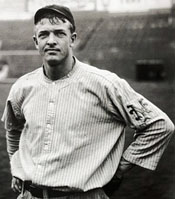 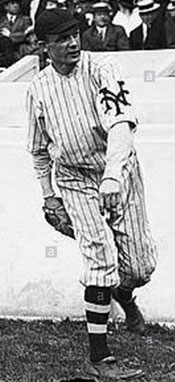   L-R: Christy Mathewson, Rube Marquard, Eddie Collins, Chief Meyers Baker Strikes Again
McGraw called on Mathewson for Game 3 at the Polo Grounds with only two days rest. The Giants eked out a run in the third against A's ace Jack Coombs. Christy twirled a shut out until the top of the ninth. He got Collins to bounce out to bring up Baker, who had grounded out twice and flied out. Let Mathewson take it from there.
In the seventh I pitched a fadeaway to Baker, and he hit the ball almost to the right field wall, where (Red) Murray caught it. I then decided to feed him curves. When he came to the bat in the ninth, I pitched him two curve balls. He missed one and the other was wide. The next I delivered was a curve over the outside corner, knee high, just where I wanted it, but (umpire) Brennan called it a ball. The next one was a curve, and I didn't want to take any chances on not putting it over, because it would get me in a three and one hole, so I laid it up better than I meant to, and he caught it on the end of his bat and drove the ball into the stand. Baker Survives Spiking, Contributes to Winning Rally
The game went into extra innings. In the bottom of the 10th, Snodgrass tried to spike Baker again on a steal of third, but Frank held the ball for the out with his uniform ripped from groin to knee. The A's broke the tie in the top of the 11th. A single to left by Collins and an infield hit to third by Baker coupled with a wild throw to first put runners on 2nd and 3rd with one out. Another error sent home the go-ahead run, and a third single plated an insurance run. That proved crucial because the Giants got an unearned run in the bottom of the inning before the potential tying run was thrown out trying to steal second.
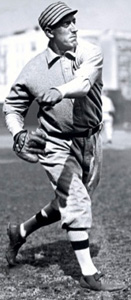 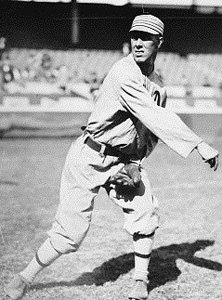 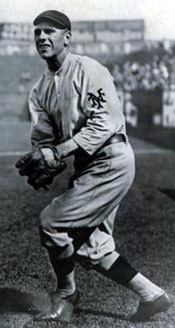 L-R: Eddie Plank, Jack Coombs, Fred Snodgrass The teams then endured six straight days of rain. During the postponement, baseball writers began referring to the A's hitting star as "Home Run" Baker, a monicker that stuck with him the rest of his career. His two home runs were worthy of acclaim when you consider that the first seven Fall Classics had produced only seven over-the-fence long balls.
Baker led the league in home runs again in 1912 with 10 and in 1913 with 12. The arrival of Babe Ruth, the switch to a livelier ball, and the elimination of doctoring the ball produced a spate of home runs in the 1920s. It would be more accurate to say that the 1911 World Series popularized Baker's nickname. Research has found that "Home Run" was applied to him as early as spring training in New Orleans before his rookie season with the A's in 1908 when he won three intrasquad games with four-baggers. |